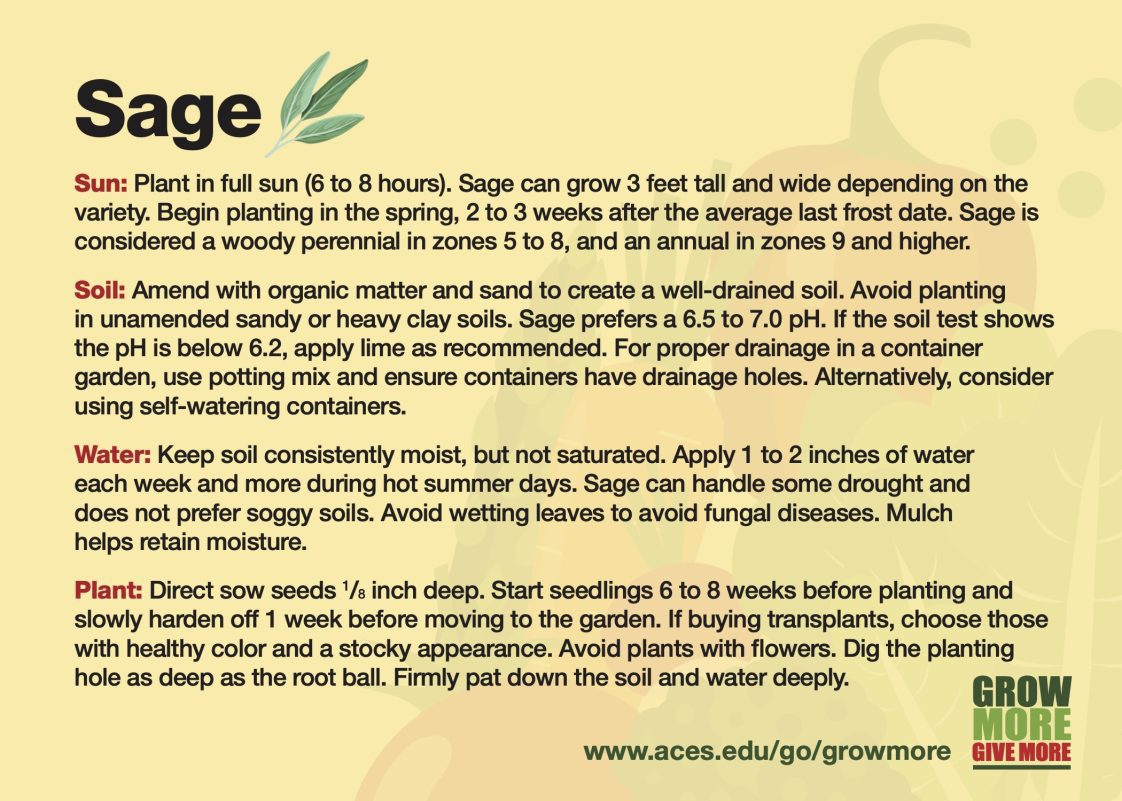Sun: Plant in full sun (6 to 8 hours). Sage can grow 3 feet tall and wide depending on the variety. Begin planting in the spring, 2 to 3 weeks after the average last frost date. Sage is considered a woody perennial in zones 5 to 8, and an annual in zones 9 and higher.
Soil: Amend with organic matter and sand to create a well-drained soil. Avoid planting in unamended sandy or heavy clay soils. Sage prefers a 6.5 to 7.0 pH. If the soil test shows the pH is below 6.2, apply lime as recommended. For proper drainage in a container garden, use potting mix and ensure containers have drainage holes. Alternatively, consider using self-watering containers.
Water: Keep soil consistently moist, but not saturated. Apply 1 to 2 inches of water each week and more during hot summer days. Sage can handle some drought and does not prefer soggy soils. Avoid wetting leaves to avoid fungal diseases. Mulch helps retain moisture.
Plant: Direct sow seeds 1/8 inch deep. Start seedlings 6 to 8 weeks before planting and slowly harden off 1 week before moving to the garden. If buying transplants, choose those with healthy color and a stocky appearance. Avoid plants with flowers. Dig the planting hole as deep as the root ball. Firmly pat down the soil and water deeply.
Fertilize: In the absence of a soil test, apply an all-purpose fertilizer (8-8-8 or 10-10-10) at planting according to label directions, and reapply each year in the spring.
Insects/Diseases/Weeds: Scout plants frequently for insect and disease damage. Use insecticidal soap (for soft-bodied insects) or Bt dust or spray (for caterpillars, or worms). Spray fungicide regularly to suppress common fungal diseases. Always follow label instructions. Mulch inhibits weeds and diseases.
Harvest: Harvest sage leaves lightly the first year, and then as needed throughout the year. Frequently harvest to keep it in a mounding shape. Since sage can be a woody perennial, prune sage if the foliage looks lifeless after winter into early spring. Prune out the oldest foliage to promote new, fresh growth.
Other: Use sage fresh, dried, or frozen. To dry sage, hang the stems in bunches in a cool dry place. Once the leaves are dried, remove from the stems and store.
Visit www.aces.edu/go/growmore for more information.
Megan Jones, Extension Agent, Home Horticulture, Auburn University
Revised September 2025, Grow More Sage, ANR-2876-KK

